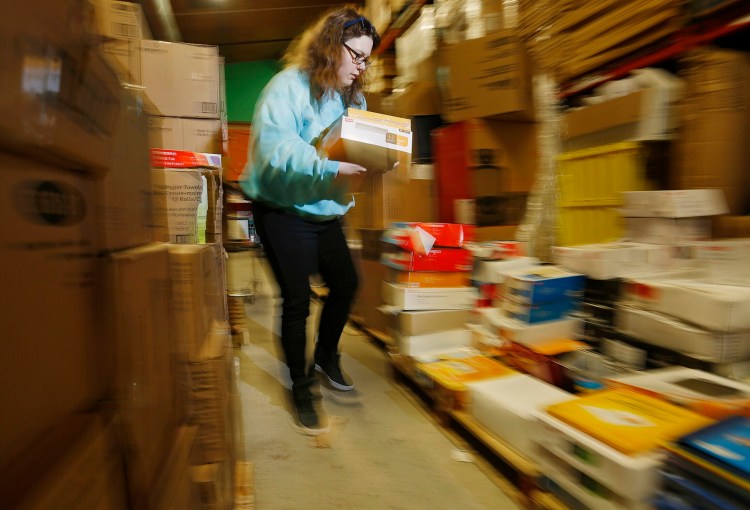Who knew a pencil has an expiration date? Ruth Libby, that’s who.
“Pencils have an expiration date on them because erasers will harden up,” said Libby, founder of the nonprofit Ruth’s Reusable Resources in Portland. “That stuff comes off the warehouse shelves and out of the stores sometimes two years ahead of (their expiration). And now they have a place to donate it and get a tax write-off.”
That place is the store that Libby and her husband have set up on Blueberry Road that looks more like a Staples warehouse than a teacher’s paradise. It started as office and craft supplies stored in the Libbys’ basement, but has grown over the years to include books, furniture and computers, all donated by private companies and office supply stores that would otherwise throw the material away.
By distributing the material to schools, Ruth’s keeps a lot of trash from entering the waste stream. Any donations that aren’t given away are recycled, if possible – down to the metal rings, vinyl and chip board in a three-ring binder. Since 2007, the organization – winner of this year’s Reutilizer Award – has recycled 177 tons of cardboard and 260 tons of paper, as well as an unknown amount of scrap metal and plastic. They’ve figured out how to recycle so much material over the years that they recently got rid of their dumpster: they no longer generated enough waste to justify the expense.

Ruth Libby, right, founder of Ruth’s Resusable Resources and Lisa Thomas-Willey, operations manager. Derek Davis/Staff Photographer
Ruth’s got its start when Libby’s own three children were in school in Scarborough and their teachers were asking parents for things like egg cartons to use in hands-on projects. Libby’s mother was working at Unum and started saving empty plastic coffee creamers, Libby said, “because it was just the right size to put a little bit of glue in for each kid, or a little bit of paint.”
Libby herself started collecting the company’s unused and unwanted pin-fed printing paper, as well, so it could be recycled as drawing paper in the classroom, along with paper clips, binder clips, and the cardboard tubes that hold wrapping paper. Soon Scarborough teachers began coming to her house to pick through all the potential supplies Libby had saved.
Today, schools pay a yearly membership fee – $3 per student, or a minimum of $650 – to buy their teachers shopping time at Ruth’s, and teachers drive hours from northern Maine and all over New England to take advantage of the donated goods. The money goes, in part, to help pay the mortgage on the building and to cover shipping costs, since supplies are now donated from all over the country. It may cost $600-700 to ship supplies from Massachusetts, according to Libby, or as much as $3,000 from Florida or Texas.
“We have to pay for that shipping to get it here,” she said, “and then I give it away for free.”
Membership fees, however, do not cover all of Ruth’s costs, so the organization supplements the fees with grants. “There were many years we had to turn the heat off in February,” Libby said.
The concept behind Ruth’s has since gone national, with other free school supply locations opening under the umbrella of the Kids in Need Foundation. Ruth’s is one of 43 organizations across the country now affiliated with the foundation, but Ruth’s has been around the longest.
Sherman Kendall, an art teacher at the Amanda C. Rowe Elementary School in Portland, has shopped at Ruth’s for about 20 years. Kendall estimates that half the art projects her students work on include at least one or two items from Ruth’s. Most recently, they used cups, yarn and felt from Ruth’s to make Ndebele dolls from South Africa. Kendall’s fifth graders used tablecloths found at Ruth’s to make pillows that they then painted with pictures by famous artists, such as Van Gogh or Monet, whom they had read about and researched.
Kendall estimates that half the teachers at Rowe, a “project-based learning school,” shop at Ruth’s at least once a year. “We could never afford to buy all those supplies,” she said. “Not in Portland.”
Val Vassar, a fifth-grade science and social studies teacher at Rowe, shops at Ruth’s about once a month. The students recently made books about Maine’s Wabanaki people from materials, including rawhide leather, from Ruth’s. When her science students study human anatomy and physiology, they build models of the digestive or nervous system using materials from Ruth’s.
“I couldn’t do (the projects) without it,” Vassar said. “There’s no way I could gather as much material as I do, and all the different kinds of materials.”
Meredith Goad can be contacted at 791-6332 or at:
mgoad@pressherald.com
Twitter: MeredithGoad
Send questions/comments to the editors.




Comments are no longer available on this story